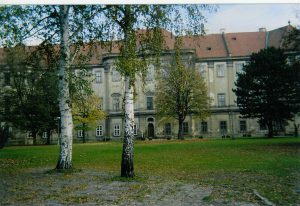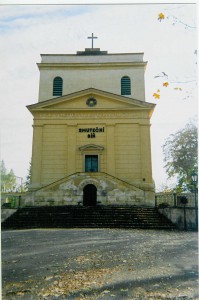Plasy Monastery
By Tracy A. Burns
Located near Plzeň (Pilsen) in western Bohemia, the former Cistercian monastery of Plasy boasts numerous Baroque ceiling and wall frescoes – even two paintings by Czech master Karel Škréta – as well as a stunning exhibition of pharmacies from three historical periods.
History
 Founded in the 12th century by Prince Vladislav II, Plasy was burned down by the Hussites in 1421 during the Hussite Wars. In the 18th century renowned architects J.B. Mathey, Jan Blažej Santini Aichel, and Kilian Ignác Dientzenhofer transformed it into the Baroque style. Things took a turn for the worse, though, when Emperor Josef II closed down the monastery in 1785. Austro-Hungarian Empire chancellor, diplomat, and politician Klement Václav Lothar Metternich bought it in the early 1800s, and now his family tomb is located in the Church of Saint Václav across the street. The monastery is associated with one particular composer as well: Bedřich Smetana spent a week here. He is not the only Czech personality to have set foot in Plasy: Czech King Václav I also stayed here on several occasions.
Founded in the 12th century by Prince Vladislav II, Plasy was burned down by the Hussites in 1421 during the Hussite Wars. In the 18th century renowned architects J.B. Mathey, Jan Blažej Santini Aichel, and Kilian Ignác Dientzenhofer transformed it into the Baroque style. Things took a turn for the worse, though, when Emperor Josef II closed down the monastery in 1785. Austro-Hungarian Empire chancellor, diplomat, and politician Klement Václav Lothar Metternich bought it in the early 1800s, and now his family tomb is located in the Church of Saint Václav across the street. The monastery is associated with one particular composer as well: Bedřich Smetana spent a week here. He is not the only Czech personality to have set foot in Plasy: Czech King Václav I also stayed here on several occasions.
The Cloister Hallway and Chapel of Saint Bernard
Walk along the Cloister Hallway, 61 meters long with eight ceiling frescoes by Jakub Pink. One tripartite fresco depicts the Virgin Mary offering food to monks while another shows the Virgin Mary helping monks work in the fields. Surprisingly, there is no furniture in the Chapel of Saint Bernard. That is because Metternich sold all of it during his tenure there. Remarkable, though, is the high wall painting of Saint Bernard, painted by premiere Czech Baroque artist Petr Brandl. Saint Bernard is leaning on a rock in a forest as angels flock above. The ceiling fresco depicts Jesus Christ and his 14 disciples.
The Chapter Hall
The 27-meter high Chapter Hall, designed by famous architect Kilian Ignác Dietzenhofer, is where new monks used to be accepted and where monks cast their votes for new abbots. Glance up at the ceiling fresco of the Virgin Mary and a gathering of monks. Try banging your fist on one of the wooden benches: The echo will last more than nine seconds.
The Former Library and Reading Room
In the second part of the former library which Metternich had changed into a theatre, there is now a Secession bureau, three tall bookcases, and a ceiling fresco depicting an allegory concerning medicine, philosophy, and theology. The circular Reading Room is home to eight larger-than-life canvases by Pink. These 18th-century Baroque paintings all deal with themes from The Old Testament concerning drinking and eating.
The Water Basins
The visitor also views two foundation water basins set there because the monastery is so close to the Střela River. These are part of an elaborate water pressure system designed by Santini Aichel, who, in order to give the monastery a firm foundation, constructed the convent on 5,100 oak piles and also created a system of connecting channels as a sort of defense against flooding. He specifically used oak wood because oak becomes hard in the water.
The Pharmacy Exhibits
The pharmacy exhibits are found in the Hospital Wing. In the Baroque pharmacy notice, the hand-made exquisitely painted pictures on the drawers and don’t overlook the drawer marked “opium.” It’s the only one with a lock on it. While the Classicist pharmacy is also impressive, the Secession pharmacy stands out due to its many floral decorations and plants on the walls, cabinets, and chandelier.
The Church of Saint Václav
 There’s more. Metternich’s family tomb is in the Church of Saint Václav. Originally a Gothic church, it was reconstructed in Baroque style. Richard Metternich, Klement V. L. Metternich’s son, was the last of the family to be buried in the tomb, in 1938. Several abbots are also buried here.
There’s more. Metternich’s family tomb is in the Church of Saint Václav. Originally a Gothic church, it was reconstructed in Baroque style. Richard Metternich, Klement V. L. Metternich’s son, was the last of the family to be buried in the tomb, in 1938. Several abbots are also buried here.
For the visitor who appreciates the Baroque and is curious about centuries-old pharmacies, Plasy is sure to enchant as a superb getaway from Prague or Plzeň.




